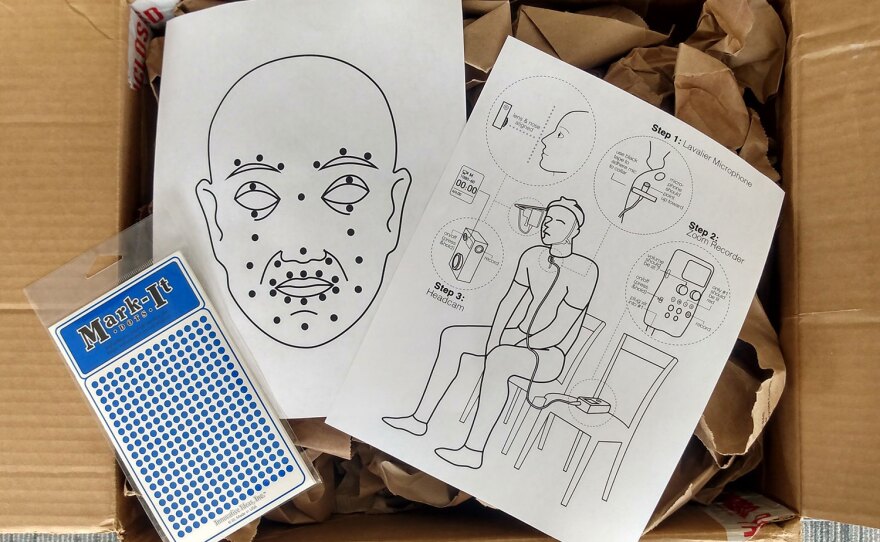In a new online video installation, "Monumental Interventions," San Diego filmmaker Evan Apodaca peels back narratives about the region's military history — using facial motion capture to animate real statues digitally placed along the city waterfront.
It's part of a larger work, "Secret City," which will eventually include a feature-length film and augmented reality components.
Apodaca started out as a studio artist, mostly working on sculpture and installations. "Tangible things," he said.
He grew up in Los Angeles and studied art in Chicago, and when he moved to San Diego, Apodaca felt somewhat untethered about his work and the art world. He turned to teaching, then ultimately to film — thanks to Media Arts Center and Digital Gym.
"I had a good handle on digital media, but I wasn't making films at that point. But I was teaching youth how to create fictional films. I taught there for probably seven years, and at a certain point I was like, no, this is what I want to do," Apodaca said.
In 2016, PBS screened Apodaca's film, "Que Lejos Estoy: Picturing Assimilation." A personal yet investigative look into his family's history, Apodaca started making that film in Cy Kukenbaker's class at City College. It's also where he laid the groundwork of animating archival photos and relics — something he builds on in "Monumental Interventions."

Art, language, histories and Orwell
Film allowed Apodaca to share stories in a relatable way. "It's a universal medium. It communicates to everyone," Apodaca said.
But installation and sculpture, as well as a contemporary and experimental approach to visual storytelling are still intrinsic to Apodaca's work in these films. The videos are documentaries about history, but they call on the language and fundamentals of art.
At the center of each video is a toppled statue, digitally placed in recognizable San Diego landmarks — mostly in front of some sort of weaponry near the waterfront.
Using facial motion capture, the statues come to life, telling real, often uncovered military histories based on Apodaca's research. It also spotlights his penchant for the surreal.
"It's just part of my artistic DNA," he said. "I would say that some of my first inclinations in art were related to repurposing analog electronic stuff, so my mental inclination is to understand how things work and sort of repurpose things, reappropriate things and create new interfaces and things like that."
Apodaca was inspired by the book "Under the Perfect Sun: The San Diego Tourists Never See" by Mike Davis, Kelly Mayhew and Jim Miller, and was also informed by a close reading of Orwell's "1984" and studying propaganda in art.
The online project opens with an introduction to the films, describing a New Unity Party and the Truth Act. It's a premise that wraps the history in a distinct, Orwellian fiction.
'What their body hides'
The animation and toppling of the monuments is a form of defacing, which can be a radical act. That's part of the point, Apodaca said, and it's also something he wants to question. Intervening and interjecting these stories in that surreal format is subversive.
"Usually these types of commemorative statues, they're just there and we're not supposed to question them. In fact, people almost would rather visually avoid them, but by not even approaching, by not questioning them, that's their power that they have. We're not supposed to question colonialism, imperialism in our built environment. So simply by inserting narratives that are not part of the popular narrative, that was my first sort of inclination. That was my form, my gesture, like defacing," Apodaca said.

The videos include altered busts of John D. Spreckels, José Rizal, Amadeo Giannini, Admiral Clifton Sprague, General Robert L. Cardenas and Benito Juárez. All of these monuments exist in San Diego.
In "Labor," a bust of John D. Spreckels describes a story about a shipyard strike in 1941 and the way so much of the infrastructure of the city of San Diego was built around the military — and what Apodaca refers to as a "Navy monoculture." The animated bust in the short video is voiced by Apodaca — the facial movements are his own, too — and it's set just in front of the USS Midway. Pedestrians and sightseers pass by, and an occasional split screen offers archival footage and clips from historic newspapers.
In another video, "Monuments," Baltimore-based professor Maria Celleri voices (and lends the facial movements) for a bust of General Robert L. Cardenas, a Mexico-born, San Diego-raised Air Force general.
"What monument symbolic destruction uncovers is what their body hides underneath them. It hides a continual, violent history of indigenous displacement," Celleri narrates as Cardenas in the video, while broken and lying on a paved plaza in downtown San Diego.
"Dominance" features a statue of José Rizal, voiced by an anonymous narrator with an exploration of human rights violations in the Philippines as a result of the U.S. military presence.

As for intent, Apodaca said that his aims evolved as he worked on the project, but the underlying theme is still a criticism of common narratives about the military-industrial complex in this city — of all branches of the military, the militarization of the border, and the apparatus and industries adjacent to the military.
"It's about two things. It's about the history of the development of the military here in a very broad, general, historical way, but it's also about moments of dissent towards the military-industrial complex, like in San Diego specifically," Apodaca said.
"Monumental Interventions," can be viewed Sept. 2-10 as an online exhibition at secretcitysd.com.






